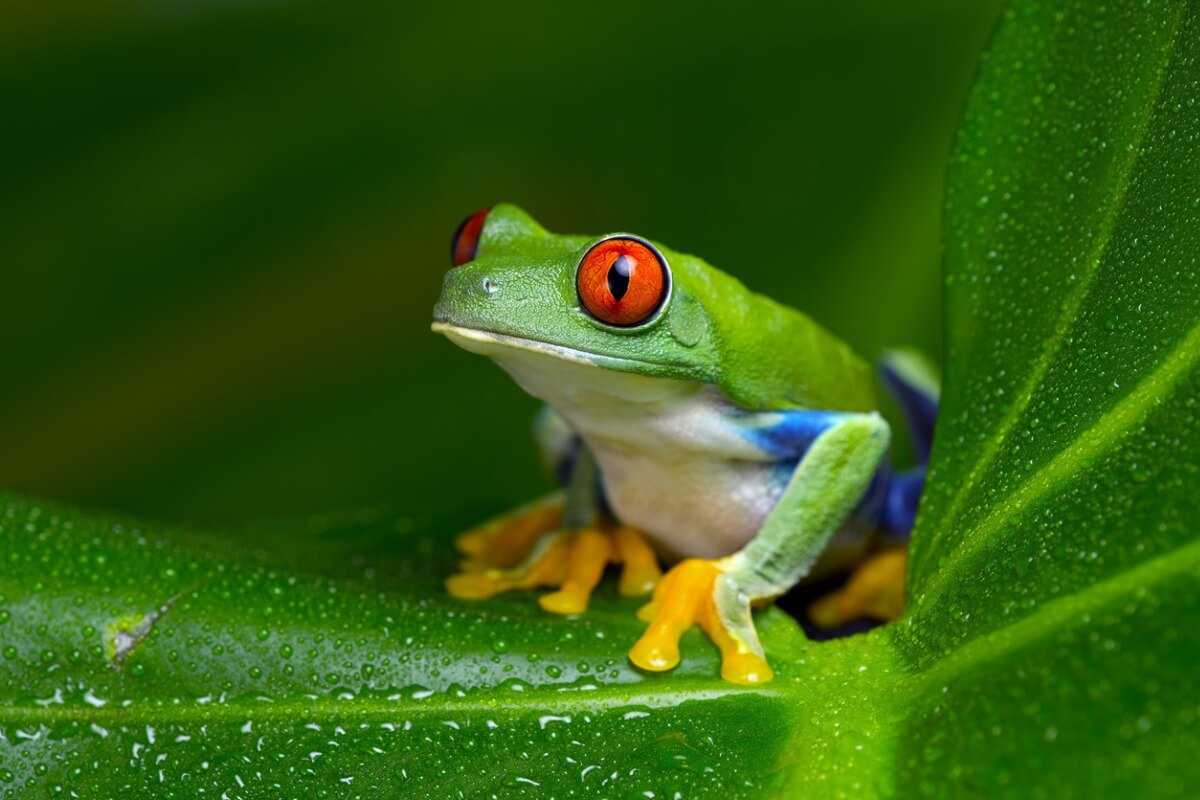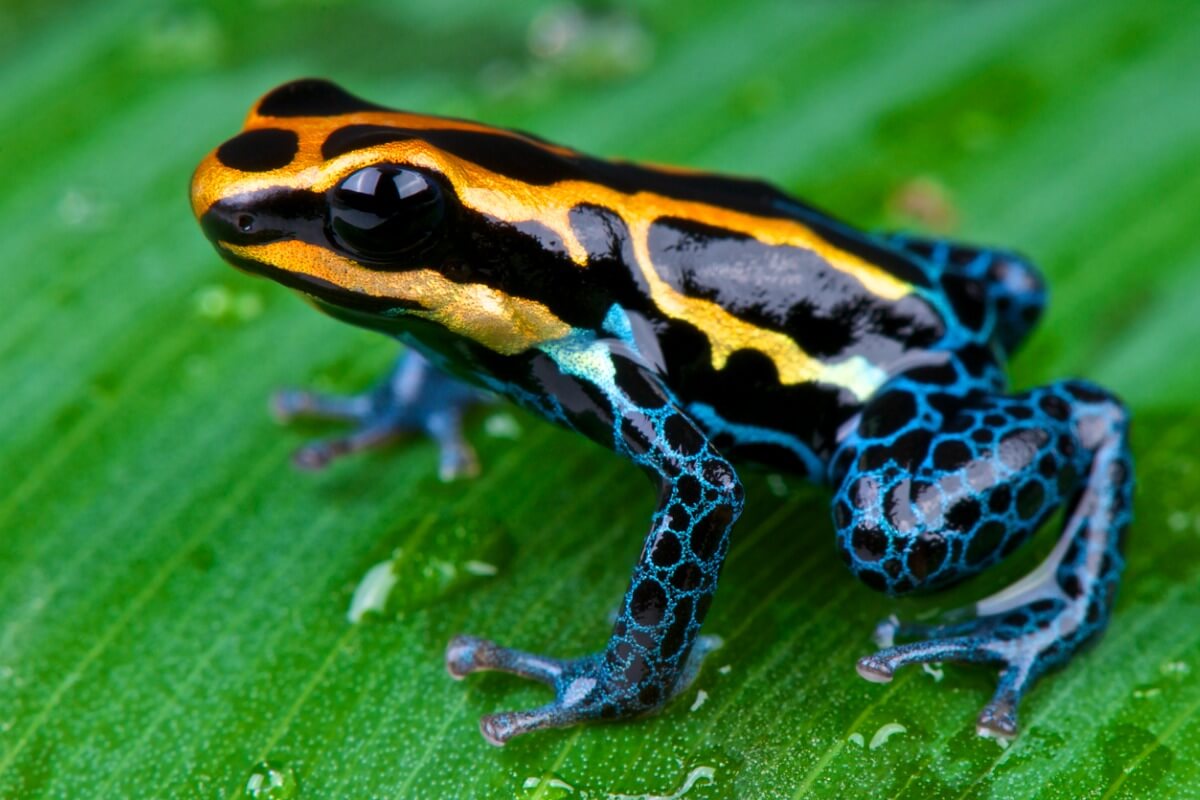The Most Common Diseases in Frogs


Written and verified by the biologist Samuel Sanchez
Amphibians are extremely delicate creatures. That’s why up to 41% of the species tested are endangered according to the International Union for Conservation of Nature (IUCN). This is due to the fact that, as they breathe partly through their skin and have very thin skin, they’re prone to suffer from epidermal and superficial diseases. Find out about common diseases in frogs in this article.
Frogs and toads are fascinating creatures, but they don’t make good exotic pets due to their complex care needs. If you have experience in looking after a terrarium and you’d like to adopt one of these small vertebrates as a pet, then you’ll need to know what the most common diseases in frogs and toads are. Keep reading and we’ll tell you all about them.
1. Chytridiomycosis
Chytridiomycosis is the disease that has caused the most havoc in the natural populations of amphibians. As professional sources indicate, more than 500 species of frogs and toads have been decimated by this disease. And 90 of them have become extinct solely due to the action of this pathogen. Without a doubt, it’s a lethal pandemic for anurans.
The cause of this condition is Batrachochytrium dendrobatidis. The cause of this condition is a fungus that infects frogs and toads’ skin progressively. When they’re severely infected, the affected amphibian is unable to breathe, osmoregulate, and coagulate, resulting in heart failure and death. Antifungals can be used to prevent it from progressing, but the disease is never completely eradicated.
This disease is common in wild frogs, but not in those bred in captivity. Your frog will only become ill if it has been removed from the wild.

2. Hypothermia
Frogs and toads are ectothermic animals, i.e. their body temperature depends on the environment. If it’s very cold in your house, the amphibian is likely to reduce its metabolism to unhealthy limits. An animal on the verge of hypothermia will be listless, cold to the touch, and immobile. It will die if action isn’t taken quickly.
To avoid this, experts recommend placing a warming blanket on one side and also outside the amphibian’s terrarium. Most species thrive well at an average temperature of 25° C (77° F). However, there are exceptions.
3. Impaction
Frogs usually have rather large mouths compared to their body size. In addition, they’re strictly insectivorous and only hunt live food. Their “sit and wait” hunting strategy (stalking until prey passes by) means that they sometimes make mistakes and end up ingesting pieces of substrate and even stones.
If the amphibian ingests a lot of substrate, it’ll eventually develop intestinal impaction. This is potentially lethal and will manifest itself with a lack of appetite and a clear difficulty in defecating. The mildest cases can be solved with warm water baths and a gentle massage to the sides of the gut. In severe cases, surgery is required.
It’s recommended to use large substrates in the terrarium, such as bark or pebbles. This makes it easier for the amphibian to spit them out if it puts them in its mouth. Sand is the worst choice in all cases.
4. Poisoning
Poisoning is one of the most common diseases in frogs. These vertebrates have a very permeable epidermis, so they tend to absorb any toxic chemical compounds found around them. In most cases, these substances will be on the hands of the keeper or in the terrarium decorations (soap, bleach and other things).
The solution to avoid this problem is very simple. Never handle your frog unless it’s strictly necessary and, if you can’t avoid it, use nitrile gloves and discard them after use. On the other hand, wash the terrarium and its accessories with boiling water, but never with ordinary chemicals.
5. Vitamin imbalances
In nature, frogs have a very varied diet and assimilate the nutrients that their prey have previously consumed (especially vitamins of plant origin). It’s necessary to smear the insects that you’re going to give to your amphibian with vitamin supplements at least once a week to make up for the deficiencies derived from life in captivity.
Don’t overdo it either, as you could create a lethal hypervitaminosis in your amphibian.
6. Dehydration
The vast majority of amphibians require a humidity of 70% or higher (up to 90%) to live well in captivity. This is because they need to keep their epidermis moist, in order to breathe through it for gas exchange. Some amphibians get up to 93% of their oxygen through their skin, so if their skin becomes dry they’ll die of dehydration.
To avoid dehydration in your frog, you’ll need to put a shallow bowl of water in order for it to get this fluid when it wants it. You’ll also need to spray the substrate daily until it’s moist, but not soggy. We recommend that you get a hygrometer and a rain system to automate the process.
A dehydrated amphibian will have dry skin and a withdrawn posture, as it’ll try to reduce its body surface area to prevent evaporation.
7. Bacterial dermatosepticemia (red-leg syndrome)
This complexly-named pathology, commonly known as redleg, refers to a skin infection. It’s one of the most common diseases in frogs, especially in those living in dirty, overcrowded, or unsuitable environments for the species. The bacteria take advantage of the immunosuppression of the weak amphibian and grow on its skin, causing the typical reddish lesions.
The prognosis of this condition is very poor, since the mortality rate ranges from 80 to 100%. However, if it’s detected early and broad-spectrum antibiotics are applied, there’s some chance of success.
This type of infection is very common in frogs that are stressed and living in inadequate terrariums. If you take good care of them, there should be no problem.

Frog diseases and the responsibility of the keeper
As you can see, there are many common diseases in frogs. Not surprisingly, they’re very delicate vertebrates that require warm, moist environments. They don’t tolerate environmental changes well, which is why they’re highly endangered in the vast majority of natural ecosystems.
Keeping a frog at home is a complex task and requires a lot of knowledge. If you feel you’re not ready, we recommend that you try to get some experience with animals that are a little easier to keep.
All cited sources were thoroughly reviewed by our team to ensure their quality, reliability, currency, and validity. The bibliography of this article was considered reliable and of academic or scientific accuracy.
- Cassidy, B. S. (2006). One frog, two fish, red leg, few fish: Stress in the aquatic animal’s ecosystem. Animal Lab News (Jan/Feb 2006).
- Weldon, C., Du Preez, L. H., Hyatt, A. D., Muller, R., & Speare, R. (2004). Origin of the amphibian chytrid fungus. Emerging infectious diseases, 10(12), 2100.
- Piotrowski, J. S., Annis, S. L., & Longcore, J. E. (2004). Physiology of Batrachochytrium dendrobatidis, a chytrid pathogen of amphibians. Mycologia, 96(1), 9-15.
This text is provided for informational purposes only and does not replace consultation with a professional. If in doubt, consult your specialist.